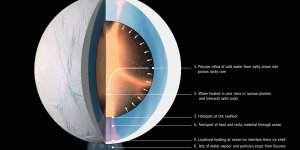| News / Space News |
Cassini Sees Dramatic Seasonal Changes on Titan
As southern winter solstice approaches in the Saturn system, NASA's Cassini spacecraft has been revealing dramatic seasonal changes in the atmospheric temperature and composition of Saturn's largest moon, Titan.

Slipping into shadow, the south polar vortex at Saturn's moon Titan still stands out against the orange and blue haze layers that are characteristic of Titan's atmosphere. ![]()
Winter is taking a grip on Titan's southern hemisphere, and a strong, whirling atmospheric circulation pattern -- a vortex -- has developed in the upper atmosphere over the south pole. Cassini has observed that this vortex is enriched in trace gases -- gases that are otherwise quite rare in Titan's atmosphere.
Cassini's observations show a reversal in the atmosphere above Titan's poles since the spacecraft arrived at Saturn in 2004, when similar features were seen in the northern hemisphere.
Heat is circulated through Titan's atmosphere via a pole-to-pole cycle of warm gases upwelling at the summer pole and cold gases subsiding at the winter pole. Cassini's observations have shown a large-scale reversal of this system, beginning immediately after the equinox in 2009.
Titan's hemispheres have responded in different ways to these seasonal changes. The wintry effects have led to a temperature drop of 72 degrees Farenheit (40 degrees Celsius) in the southern polar stratosphere over the last four years.
This contrasts with a much more gradual warming in the northern hemisphere, where temperatures remained stable during the early spring and have shown just a six-degree increase since 2014.
Within months following the equinox, the vortex in the stratosphere over the south pole had become prominent, as had an atmospheric "hot spot" at high altitudes. The corresponding features in the northern hemisphere had almost disappeared by 2011.
Inside the polar vortex over the increasingly shadowed south pole, there has been a rapid build-up of trace gases that accumulate in the absence of ultraviolet sunlight. These include complex hydrocarbons previously only seen at high northern latitudes. (NASA)
YOU MAY ALSO LIKE




